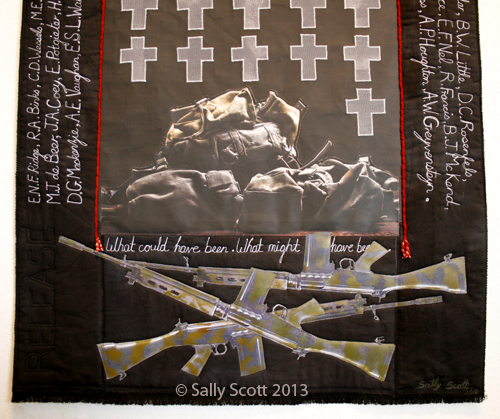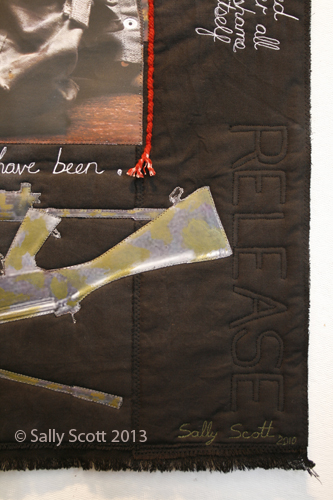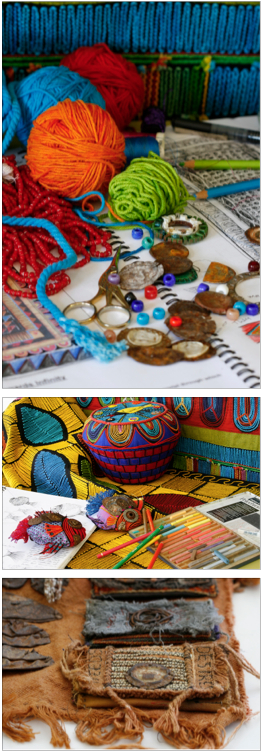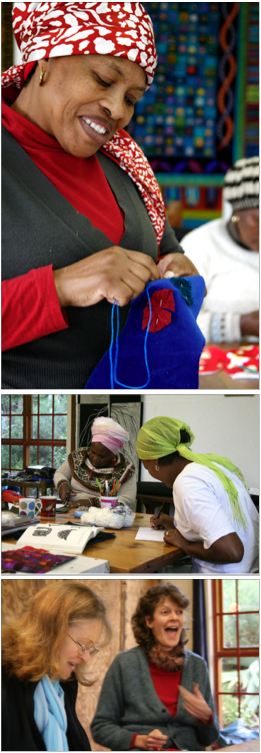A couple of weeks ago, whilst the National Arts Festival was underway in Grahamstown, I was invited to present and speak about my large textile artwork, In Memoriam, at the LAWS (Legacy of the Apartheid Wars) Conference, organized by Theresa Edlmann of the History Department at Rhodes University.
The purpose of this cross-disciplinary conference was to bring people together from all sides of the various conflicts to share their views and perspectives on addressing the legacies of these wars. In my case, I shared my own personal story of being married to an officer in the Rhodesian Light Infantry during the Rhodesian Bush War and the struggles that we and so many others like us, faced in the aftermath. I spoke of the inspiration that led to me making the work and explained some of the symbolism it contains.

IN MEMORIAM
2 panels, each 234.5cm x 77cm
Medium: Photographs on canvas, cotton fabric.
Machine embroidery and applique
The History of this Work
In January 2010, after a visit to the now largely disintegrated and overgrown ruins of Fort Wiltshire, in the Eastern Cape, I came upon a small graveyard, containing the remains of British soldiers and their families. On reading the inscriptions on the tombstones, I was struck by the intensity of emotion that was etched so deeply into the rock, and was moved by the poignancy of these weathered, old gravestones standing stoically amongst the encroaching bush, holding their ground in silent testament to the brave men of years gone by. This got me thinking more about the meaning and purpose of monuments and gravestones, which essentially are an acknowledgement of lives spent and pain suffered and mark a time when something or someone ceased to be. They serve an important purpose in that they offer recognition of the contributions made and the value of the life of the person or people to whom they are dedicated. This may help those who are left behind to remember, forgive, release and move on.
War and Memorial
My knowledge and experience of war came initially through being the daughter of an ex World War 2 RAF bomber pilot, and then more directly through being married to an officer in the Rhodesian Light Infantry during the Rhodesian Bush War (1964 – 1979.)
I remember as a child being very aware that my father, as a member of the Allied Forces, had been a hero in what was widely perceived as a just war. I grew up knowing that he had served with valour and that he and his fellow servicemen had been remembered through numerous monuments and annual celebrations of their bravery.
However, when Rhodesia became Zimbabwe, the few memorials dedicated to the Rhodesian forces had to be smuggled out of the country for safe keeping. As a result there is nothing tangible in Southern Africa that memorializes these men, nothing that formally acknowledges how their lives were changed forever by their war experience.
When the Rhodesian Bush War came to an end, the ground was literally cut out from under those who had served in the Rhodesian Security forces, leaving many of them in a state of limbo, brimming with tension and unresolved conflict. As happens after many such wars, this lack of closure created an ongoing internal, emotional struggle that has in many cases had a profound ripple effect in their lives.
War Memoirs
For years I have planned to write a book about my life and the journey I have taken, but the obstacle that has stood in my way that I have really preferred to avoid, was the period encompassing this war and, like many others who served in the security forces, the difficulties my husband and I faced in the aftermath. However, my visit to the forts and the graveyard kick started the process and for the next few months I tackled the subject head on, launching myself into an intense period of writing, where I was forced to recall the deepest, darkest, and at times happiest period of my life. Whilst very emotionally exhausting, the writing of these memoirs helped me release much of what had effectively been holding me back. In recalling my experience of war, I was able to remember the love and compassion I felt for those men, who on the whole were good, decent guys, born into a country and an era where they were expected to go and fight. In confronting my past, I was reminded of the sacrifices that the Rhodesian forces had made and I emerged from the process feeling very deeply that they need to be acknowledged and remembered.
It was with this in mind that I began to explore the idea of creating my own memorial, not only to these, the men that I knew, but to all soldiers wherever they may be. My recollections had reminded me that soldiers are not faceless numbers, as they are so often portrayed, but are sons, brothers, fathers, husbands and lovers, all doing what they have been called to do. The following is an extract from my journal, written during this time of reflection:
“It is 2010, thirty years since the Rhodesian Bush War was politically brought to an end. A lot has happened in thirty years, much water under the bridge. With time and hindsight one has a clearer view of all that happened back there in the day when brave young men made a decision to stand and fight for a cause that they believed in. So much was lost in that war and very little was won. Lives were lost, as they always are in war, a country was lost, no longer with the same name, ‘home’ was lost, as were families and farms, livelihoods and dreams. With the signing of the peace agreement, came the start of a brand new struggle, a) within the hearts and minds of those who remained and b) within the souls of those who left. Whichever side of the battle they were on, people were damaged and lost, one way or another. So, as I sit remembering the war, I feel the need to document it in some way. Having witnessed firsthand the struggles so many experienced, I feel the need to acknowledge the loss, the pain of those who lived and died, and those who have never really found the peace that they seek. These wall hangings, therefore, are a tribute to the men who lost their lives – in death and in life. These works do not glorify war, nor do they take sides, they are merely an acknowledgement of lives lost and pain suffered for a cause that was deemed worthy at the time.”
In Memoriam
The work is made up of two long panels. The first one is dedicated to the men who die in war and the other is for the soldiers who survive. They hang side by side and are of equal importance. As this work arose directly from my own personal experience, it refers specifically to the men I knew, the men of the Rhodesian Light Infantry. However, I believe that the message it contains is universal and applies to men on both sides of any conflict. The important thing here is not that one must feel obligated to read all the names inscribed, but to know that all lives lost in war are valuable and woven into the cloth of our collective memory.
1. For Those Who Die
The backdrop to this scene is sunset (or could it be sunrise?) over the Zambezi Valley. Superimposed over it are transparent crosses marking the 86 men from the Rhodesian Light Infantry who lost their lives in action. Their names are embroidered in white onto the black border than surrounds the scene.
Here is another excerpt from my journal, written the day I did the embroidery:
“I feel the need to honour the men of our unit, and as I embroider all their names onto the cloth, I am aware that I must take care with each and every one of them, for they are all loved and remembered by someone, and I will give each one the reverence he deserves.”
2. For Those Who Live
This piece is dedicated to the men who go through war and make it to the other side. Upon their release from duty, they take with them the physical, mental and emotional scars of their journey, but lose the authority and recognition that they have been accustomed to. They are then expected to carry on business as usual as if the war had never happened. The task is near impossible, for a man who has lived through war will never be quite the same again. The challenge is for him to take what he has learned from his experience and redefine it in such a way that he is able to forgive and truly release himself from the bonds of this turbulent past. In my view, this challenge is equal to the magnitude of his sacrifice.
The imagery used as the central motif in this panel, is an enlarged detail from a previous piece of work, done in 2003. It relates directly to sacrifice, and may be interpreted in whatever way is meaningful to the viewer. The original inspiration for the image came from seeing the grave of a Himba chief in a remote area of bush in the Kaokoveld area of Namibia. Above the grave stood a marble cross and behind this was a pole onto which had been hammered the skulls of all his cattle that had been sacrificed for their master. It was a haunting image that took on a slightly different meaning when seen in the context of this work. The thorns that had originally been used to represent the horns of cattle could now be linked to the sacrifices made by men who go to war, or, amongst other things, be seen as symbolic of Christ and his crucifixion. On reading the poem that inspired this panel, it seemed a fitting association.
I chose the following poem to embroider into the work, for it closely echoes how I feel about all the men to whom this work is dedicated, but in particular the men of the RLI. They were my men – the ones I loved and understood. I have seen their vulnerability, their courage and their fear, and I have witnessed their bestiality, their bravado and their pain. They were good men and deserve to be remembered. I hope that this monument to their bravery will in some small way help them to find the release and the peace that they so richly deserve.
Soldiers Bathing (abridged version for artwork)
By F.T. Prince (1954)
The sea at evening moves across the sand.
Under a reddening sky I watch the freedom of a band
Of soldiers who belong to me. Stripped bare
For bathing in the sea, they shout and run in the warm air;
Their flesh worn by the trade of war, revives
And my mind towards the meaning of it strives.
All’s pathos now. The body that was gross,
Rank, ravenous, disgusting in the act or in repose,
All fever, filth and sweat, its bestial strength
And bestial decay, by pain and labour grows at length
Fragile and luminous. ‘Poor bare forked animal,’
Conscious of his desires and needs and flesh that rise and fall,
Stands in the soft air, tasting after toil
The sweetness of his nakedness: letting the sea-waves coil
Their frothy tongues about his feet, forgets
His hatred of the war, its terrible pressure that begets
A machinery of death and slavery,
Each being a slave and making slaves of others: finds that he
Remembers his old freedom in a game
Mocking himself, and comically mimics fear and shame.
He plays with death and animality…
And we too have our bitterness and pity that engage
Blood, spirit, in this war. But night begins,
Night of the mind: who nowadays is conscious of our sins?
Though every human deed concerns our blood,
And even we must know, what nobody has understood,
That some great love is over all we do,
And that is what has driven us to this fury, for so few
Can suffer all the terror of that love:
The terror of that love has set us spinning in this groove
Greased with our blood.
These dry themselves and dress,
Combing their hair, forget the fear and shame of nakedness.
Because to love is frightening we prefer
The freedom of our crimes. Yet, as I drink the dusky air,
I feel a strange delight that fills me full,
Strange gratitude, as if evil itself were beautiful,
And kiss the wound in thought, while in the west
I watch a streak of red that might have issued from Christ’s breast.












Beautiful Sally….so moving!
Thank you, Rusty. It’s great to have re-connected with you after all these years, as you were so much a part of this journey.
Hi there Sally. I love you work. Awesome and inspiring. Blessings. Cecil van den Bergh
Hi Cecil. Many thanks for your comments. It’s great to know that you find the work meaningful. Best wishes…
Dear Sally, well done and beautifully put across.
“So much lost an very little won” just sums it up perfectly in only a few words. A wonderful tribute to those true heroes who lost their lives…….and just like that it was all over !
Kind regards,
Rod Watson, from Durban when we first met.
Now living in Western Cape
Hi Rod. Thank you for your comment and I am glad you found my thoughts meaningful. War is a very complex beast and I do believe that anyone who has experienced it, even in the smallest way, is somehow changed forever. It’s important that we remember those who gave their lives to it.
On a lighter note, it’s so good to hear from you again after all these years and I hope you will stay in touch.